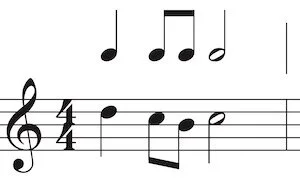Session 3
Staccato
Staccato is a short and detached bow stroke without any heavy accents. The duration of the pitch is shortened to achieve this cut sound. The bow does not leave the string and each pitch should have a distinct short and detached tone.
Staccato in string can be performed with alternate bows or in a single bow stroke. Slurred Staccato or Up/Down-Bow Staccato has the same articulation and the resulting sound is separate bow staccato. The bow is stopped for each note and does not leave the string.
Two slurred staccato up bow notes are often found in minuets and sometimes referred to as the ‘minuet bow stroke.’
There are many different types of Staccato including off the string staccato. These are often used in classical repertoire in an upbeat setting (also known as an anacrusis pick-up).
Collé and Spiccato strokes are rapid and complex forms of Staccato. These require a separate set of techniques and are not covered in this course.
No matter the type of Staccato, the notation is always the same – a dot above the pitch.
D major Scale
Notation Symbols
– = Shift
X = Extension
Strategies
D major scale invites an awareness of your thumb placement. Keep it behind your second finger, particularly for extensions in the lowest octave. Remember to take it with you at the same time as you extend forward or backwards with your second finger.
Etudes: Slurred Staccato
Beginner – Schroeder X
Improver – Schroeder X
Advanced – Schroeder X
Please prepare Schroeder X for the live class
Practice Assignment
Step 1: revisit your Martalé stroke and remove the heavy hammer articulation from the sound. Instead aim for an even tone and detached quality of sound without accents.
Step 2: cut the duration of the pitches into half. For example, practice quarter note staccato as eight note staccato sounds with an eighth note rest between. You should hear a distinct silence (or ring) between each pitch.
Step 3: increase the tempo but maintaining a short and detached bow stroke with no heavy accents.
Step 4: practice upbeat/pick up/anacrusis staccato passages (airplane landing) where you perform an up bow staccato starting in the middle or balance point. Then, you ‘land’ at the frog, sink into the string and then pull the bow. Don’t allow your bow to pull before the hair is touching and has sunk down into the strings. No crash landings.
Step 5: Apply this technique to your D scales etude making the sound of a crispy staccato as your priority.
Advanced players: practice all above steps with Up/Down Bow Slurred Staccato. First isolate just the up-bow technique, using the same bow distribution for every single pitch. Then, practice getting into it by playing a full down bow, stopping the bow and then continuing with the up bow staccato stroke. Find the piece the you’ve played these in and practice scales in this way, both on a single pitch and also using more complex pitch patterns such as changing strings and adding multiple pitches.
Live Session 3: Bow Angle & Thumb
During our live sessions:
you will have an opportunity to demonstrate Staccato bow stroke and receive feedback from me.
together we will apply this technique to D major scale and Schroeder X etude.
as a group we will review bow stick angles
and work on a relaxed and flexible right thumb
What more help?
If you want more detailed feedback than in our group live sessions, I am available for 1:1 coaching sessions throughout the course for an additional fee. Please contact me if you’d like to schedule a private session.

